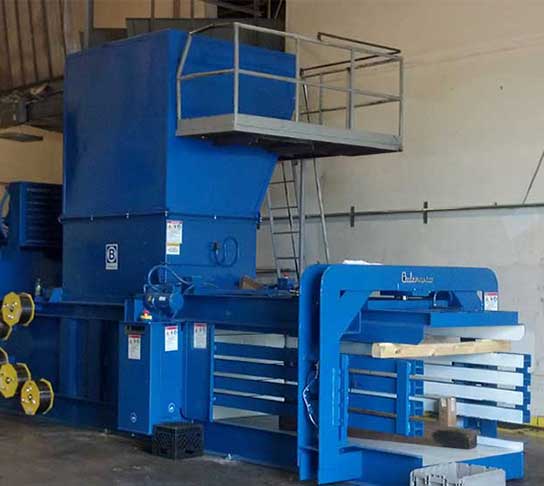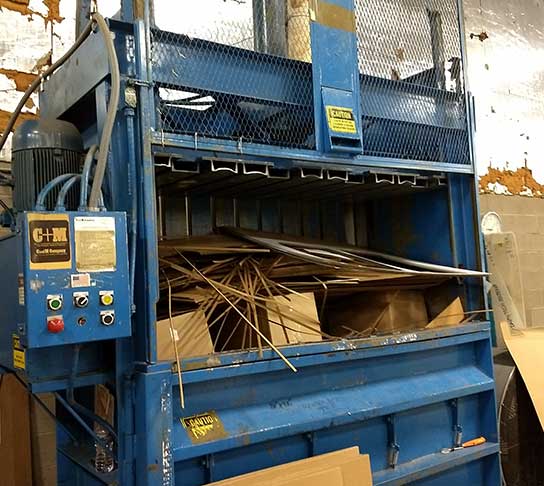Balers come in all shapes and sizes, and they serve in multiple applications. Balers have many applications and uses across the recycling industry. In most cases, a baler is used to contain items that generally take up a great deal of space. You can find these balers in manufacturing facilities, retail stores, recycling facilities and other businesses that need to manage waste.
The primary purpose of a baler is to pack massive amounts of recyclable material into a compact size and shape. By compacting the recyclable material, you make it easier to store and ship.
WHAT TYPE OF BALER DO I NEED?
A balers efficiency is defined by how well it densifies the material it bales. The volume of material determines what kind of baler you will use in your application. Another consideration that may affect your efficiency is how restricted you are for space.
When customers are looking to acquire a baler, the first thing they ask, is “What do you recommend?” The first consideration is what you need the baler to do. Balers can compress and package the following materials:
- Aluminum
- Bottles
- Cardboard
- Cans
- Foam
- Plastics
- Steel
- Textiles
After the material is compressed, it is then ready to be transported to the dump or a recycling plant. So, your first decision is to determine what types of materials you are baling.
VERTICAL (DOWNSTROKE) OR HORIZONTAL BALER?
Almost every baler used today can fall into one of two categories;
- Vertical (Downstroke) Balers
- Horizontal Balers
VERTICAL (DOWNSTROKE)
Downstroke or Vertical Balers balers are ideal for materials like cardboard, PET plastics, and foam. When you load the material in the vertical baler, it’s crushed, to reduce volume. When the baler is full, a bale is created and manually tied with baling wire, then you eject it from the machine.
An excellent example of this would be a supermarket or grocery store. Supermarkets generate a great deal of cardboard, and it can overwhelm them if not contained. Most grocery stores have vertical balers. Vertical balers don’t take up much floor space and can handle all the cardboard generated in the store.
To extend the life of your vertical baler we recommend a preventative maintenance program from US Recycling Equipment.
THE ADVANTAGES OF VERTICAL BALERS
Vertical (downstroke) Balers have three main advantages over horizontal balers.
Lower Initial Investment: The capital investment needed for a vertical baler much less than horizontal balers.
Vertical Balers Have A Small Footprint: Vertical balers don’t need as much space as a horizontal baler. Because of this, they can function in a more extensive variety of applications.
Wider Range Of Material Processing – While some vertical balers are specialized, they are made to handle paper, textiles, steel, aluminum, plastic bottles and more.
At US Recycling Equipment we work with some of the finest manufacturers in the industry. Our most recommended line is from BACE Baler and Compaction Equipment. Please take a look at their site to see their full range of vertical balers.
HORIZONTAL BALERS
Horizontal balers are used more for high volume applications, and they process waste differently. Horizontal balers have a hopper to collect the material and feed it to be compressed. After compression, a wire is used to tie the bale and then eject it from the side.
THE FOUR MAIN ADVANTAGES OF A HORIZONTAL BALER:
Can be fully automated: – Fully automated means that they can function with minimal personnel involved, saving on labor resources.
Higher volume: – Horizontal balers process a higher amount of material than vertical balers. Also, each bale they produce is larger.
More consistent output: Each bale produced is more consistent in weight and density. This consistency makes it easier to handle and store.
More extensive range of material processing: Application can be cardboard, paper, plastic, steel, aluminum.
In many cases, horizontal balers have an Auto Tie System as opposed to manual tie. The horizontal baler will also have a conveyor option to assist in moving the product through the machine. It would be best if you considered a horizontal baler when you need to process quantities on material larger than 50 tons per hour.
Want to gain more insight into horizontal balers, we sell, and service at US Recycling Equipment? Visit Balemaster Horizontal Balers, the leading manufacturer of reliable horizontal balers.
CONCLUSION
There is a lot to think about when considering what type of baler is best for your operation. US Recycling Equipment has years of experience working with recycling facilities, manufacturing, retail. Experience you can take advantage of to find the right baler solution and we are here to help you.
To maintain your baler, consider a preventative maintenance program to ensure your balers stays up and running without unnecessary downtime. Contact us today on our website, or give us a call at 303-408-5312. We are here to help.
Scheduled and preventative maintenance is critical to the life-cycle of your baler.




